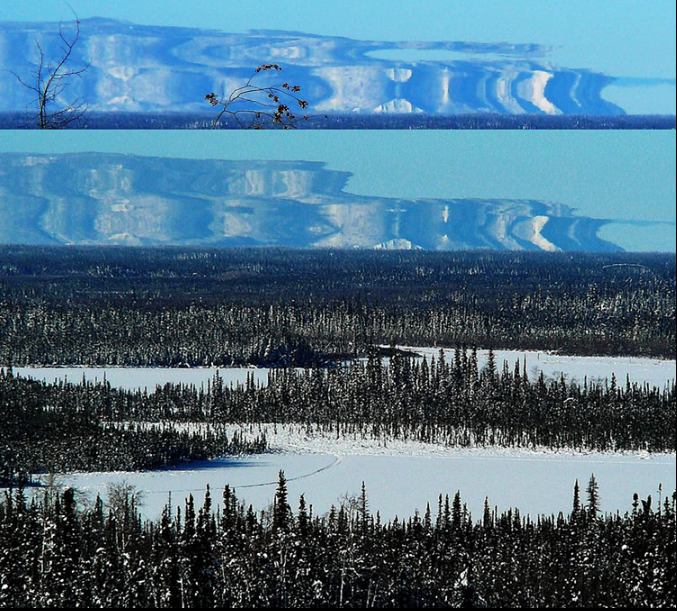Today's Feature Mirages, Fata Morgana
Today's Feature Mirages: Exploring the Fascinating Fata Morgana
Mirages have long captivated our imagination with their ethereal and elusive nature. Among the various types of mirages, one stands out for its extraordinary visual effects and mystical allure: the Fata Morgana. Named after King Arthur's enchantress half-sister, this superior mirage forms when light from distant objects is refracted between layers of very cold dense air overlaid by warmer air. In this article, we will delve into the captivating world of Fata Morgana mirages, exploring their mesmerizing characteristics and the intriguing ways in which they transform our perception of reality.
A Fata Morgana mirage is distinguished by its vertical stretching of images, which can create the illusion of apparent cliffs or fantastical towers. This distortion occurs as light rays bend when passing through air layers with different temperatures and densities. As a result, the mirage appears above the actual object, giving it a superior quality. The vertical magnification of these mirages plays a crucial role in producing remarkable visual phenomena, such as the formation of green flashes during sunset.
One fascinating aspect of Fata Morgana mirages is their ever-changing nature. Not only do they vary with time, but they also transform depending on the observer's height relative to the air layers. As you move and shift your perspective, the mirage unfolds before your eyes, revealing new and astonishing optical illusions. This dynamic quality adds to the enigmatic allure of Fata Morgana mirages, making them a subject of great fascination for scientists and enthusiasts alike.
The visual spectacle created by Fata Morgana mirages can be truly awe-inspiring. Imagine witnessing seemingly solid cliffs or towering structures materialize in the distance, only to dissipate moments later. These mirages possess an otherworldly quality, transporting us into a realm where reality and illusion merge. It is no wonder they have captured the imagination of artists, writers, and storytellers throughout history.
Fata Morgana mirages often occur in polar regions, where the stark temperature contrasts between the frigid air near the surface and the relatively warmer air above create the ideal conditions for their formation. The Arctic and Antarctic regions are particularly renowned for these mirages, offering breathtaking displays of mirage-induced optical phenomena. However, Fata Morgana mirages can also occur in other geographical areas under specific atmospheric conditions, adding an element of unpredictability to their occurrence.
To fully appreciate the beauty and complexity of Fata Morgana mirages, it is essential to observe them under optimal conditions. Clear skies and stable atmospheric conditions are key factors in ensuring a vivid and immersive mirage experience. Patience and perseverance are often required, as these mirages may appear fleetingly or require careful observation to discern their subtle details.
In conclusion, Fata Morgana mirages represent a captivating phenomenon that showcases the intricate interplay between light, temperature, and atmospheric layers. Their superior nature and vertical stretching of images create visually stunning illusions that challenge our perception of reality. Whether you are an avid observer of atmospheric optics or simply curious about the wonders of the natural world, encountering a Fata Morgana mirage is an experience that will leave you in awe of the mysterious and enchanting forces at play in our atmosphere.

Fata Morgana Mirage
Imaged by David Cartier (photography) on 20th February above the Tetlin Hills of Eastern Alaska.
When light from hills or other distant objects is refracted between layers of very cold dense air overlaid by warmer air it forms a 'superior mirage'. Superior because the image is above the real object.
Images can be strongly stretched vertically forming apparent cliffs or fantastical towers - this is a 'Fata Morgana' named after King Aurthur's enchantress half sister.
As here, the mirage changes not only with time but with your own height relative to the air layers.
Mirages at sunset produce incredible sun shapes and their vertical magnification is essential to form green flashes.
Image ©David Cartier, shown with permission.
Note: this article has been automatically converted from the old site and may not appear as intended. You can find the original article here.
Reference Atmospheric Optics
If you use any of the definitions, information, or data presented on Atmospheric Optics, please copy the link or reference below to properly credit us as the reference source. Thank you!
-
<a href="https://atoptics.co.uk/blog/todays-feature-mirages-fata-morgana/">Today's Feature Mirages, Fata Morgana</a>
-
"Today's Feature Mirages, Fata Morgana". Atmospheric Optics. Accessed on October 21, 2024. https://atoptics.co.uk/blog/todays-feature-mirages-fata-morgana/.
-
"Today's Feature Mirages, Fata Morgana". Atmospheric Optics, https://atoptics.co.uk/blog/todays-feature-mirages-fata-morgana/. Accessed 21 October, 2024
-
Today's Feature Mirages, Fata Morgana. Atmospheric Optics. Retrieved from https://atoptics.co.uk/blog/todays-feature-mirages-fata-morgana/.